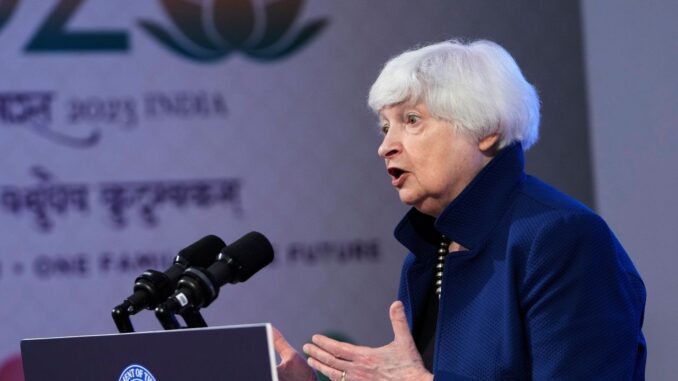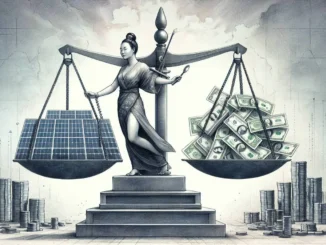
The global economy’s brief run of good luck may be ending.
Manufacturing activity is weakening across the world. Europe slid into a mild recession earlier this year. China’s much-anticipated rebound from Covid-19 lockdowns is sputtering. Many emerging markets continue to struggle with heavy debt burdens and high interest rates.
Still, central bankers and finance ministers from the Group of 20 major economies gathering in Gandhinagar, India, this week can in many ways breathe a sigh of relief. Headline inflation is dropping. Labor markets in many countries remain strong. Many of the worst-case scenarios officials stressed about after Russia’s invasion of Ukraine last year—from a cascade of defaults across the developing world to a deep recession in Europe—haven’t come to pass.
The question now for the world’s top economic officials is whether they can keep dodging the worst consequences of the threats they face, from restrictive monetary policy to a slowdown in global trade.
“While prospects are mixed in the near term, the medium-term outlook for the global economy remains bleak,” said Kristalina Georgieva, the managing director of the International Monetary Fund.
China’s weakness looms large
While economists polled by the Journal expect China to report around 7% in second-quarter growth on Monday, global officials are still closely watching the world’s second-largest economy.
Chinese exports last month were down precipitously from a year earlier, while consumer inflation is flat—a sign of weak demand that raises the risk of deflation. While central banks around the world increase interest rates, China’s has cut them in a bid to stimulate the economy.
U.S. Treasury Secretary Janet Yellen is among the top officials meeting this week to try to decide what is next.
During a press conference on Sunday ahead of the G-20 meetings, U.S. Treasury Secretary Janet Yellen said she was briefed on China’s economic plans when she was in Beijing last week.
“Of course it is significant to the global economy,” Yellen said. “China is a very substantial importer for many countries around the world so when Chinese growth slows it has an impact on growth in many countries. And we are seeing that.”
She also said that it would be “premature” for the Biden administration to consider lifting tariffs on more than $350 billion in Chinese exports to the U.S.
The slowdown in Chinese exports and global trade partly reflects the consequences of high interest rates and global consumers’ return to services after heavily buying goods during the Covid-19 pandemic. But some economists are concerned about a more persistent drag on trade and growth as the U.S. and China try to create distance between their economies.
Many multinational companies have been exploring shifting pieces of their operations outside of China, including to India, while the U.S. and its allies offer fresh incentives to reshore some forms of manufacturing. Foreign direct investment into China, a key source of development and growth, collapsed in the first quarter of this year.
A reorientation of global supply chains is expected to play out over many years, potentially affecting growth in China and raising prices for global consumers in the longer run.
“It’s a slow process because there is no infrastructure or ecosystem in southeast Asia that can quickly replicate the efficiencies that the Chinese market provides,” said Nirav Patel, chief executive of advisory firm the Asia Group.

Chinese exports last month were down precipitously from a year earlier.
Eyes on the Fed
For a global economy wedded to the dollar, signs last week that inflation in the U.S. has cooled significantly from last year’s peak are encouraging, but many economic officials remain on edge about the Federal Reserve.
The Fed is on track to raise rates again at its coming meeting in July. But how much further it could raise rates after that—and how long rates could remain elevated—is still uncertain as Fed officials battle stickier core inflation. The aftermath of the collapse of Silicon Valley Bank and Signature Bank this spring has also tightened credit conditions in the U.S., potentially weighing on growth.
“My experience at G-20 meetings is that when the Fed reports on the U.S. economy and U.S. monetary policy, the room is quiet and people are on the edge of their seats,” said Nathan Sheets, global chief economist at Citi and a former Fed and Treasury official.
Strong hiring and consumer spending so far has led some economists polled by the Journal to dial back their expectations for a U.S. recession, but most still forecast the world’s largest economy will enter one in the next 12 months.
Low-income economies remain at risk
Rising interest rates in the U.S. last year drew capital into dollar-denominated assets, pushing up the value of the dollar dramatically. That created problems for many low-income countries that use dollars to pay their debts, as well as to import food and energy.
While the dollar has retraced many of those gains this year, the IMF is warning that the uncertainty of the Fed’s future path creates the risk for poorer countries of further dollar appreciation. More than half of low-income countries and about a quarter of middle-income countries are in debt distress or at high risk of it, according to the IMF.
Russia’s invasion of Ukraine also weighed on low-income countries, disrupting supplies of food and energy and pushing up inflation around the world. Depending on how the war shapes up, those pressures could re-emerge. Europe’s economy, which suffered last year as Russia cut off its supply of natural gas, is particularly vulnerable.
“The shocks will come but we don’t know what shocks will come,” Magdalena Rzeczkowska, Poland’s finance minister, said in an interview this spring. “There is a lot of uncertainty as far as the future is concerned.”



